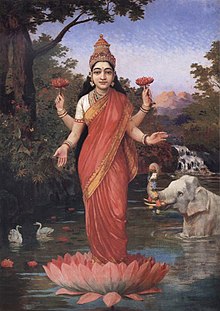
Parashurama, also referred to as Rama Jamadagnya, Rama Bhargava and Virarama, is the sixth avatar among the Dashavatara of the preserver god Vishnu in Hinduism. He is believed to be one of the Chiranjivis (Immortals), who will appear at the end of the Kali Yuga to be the guru of Vishnu's tenth and last incarnation, Kalki.

Rākshasa are a race of usually malevolent beings prominently featured in Hindu mythology. They reside on Earth but possess supernatural powers, which they usually use for evil acts such as disrupting Vedic sacrifices or eating humans.

Arjuna, also known as Partha and Dhananjaya, was an ancient Indian prince of the Kuru Kingdom discussed in the epic, Mahabharata. He was the third of five Pandava brothers, from the lineage of the Kuru. In the Mahabharata War, Arjuna was a key warrior from the Pandava side in the battle of Kurukshetra. Before the beginning of the war, his mentor Krishna gave him the supreme knowledge of the Bhagavad Gita to overcome his moral dilemmas. Arjuna was the son of Kunti, the wife of Kuru King Pandu, and the god Indra, who fathered him due to Pandu's curse. In the Mahabharata, Arjuna is depicted as a skilled archer from an early age, as a student who earns the favor of his preceptor Drona, as the primary adversary of Kauravas, and the betrothed of Draupadi, who became the common wife of the Pandavas. Arjuna is twice exiled, first for breaking a pact with his brothers, and again with his brothers after his oldest brother is tricked into gambling away the throne. During his first exile, Arjuna married Ulupi, Chitrāngadā and Subhadra. From his four wives, Arjuna had four sons, one from each wife — Shrutakarma, Iravan, Babhruvahana and Abhimanyu. During his second exile, Arjuna gained many celestial weapons. Apart from being a warrior, Arjuna also possessed skills in music and dance. At the end of the epic the Pandavas, accompanied by Draupadi, retire to the Himalayas, where everyone in time passes away to arrive in heaven.
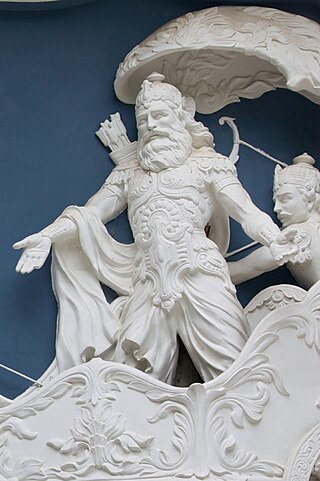
Bhishma, also known as Pitamaha, Gangaputra, and Devavrata, is a major character of the epic Mahabharata and the protagonist of the Bhishma Parva episode. He was the supreme commander of the Kaurava forces during the Kurukshetra War of the epic. He was the only character who witnessed the entirety of the events of the Mahabharata, beginning from the reign of his father, King Shantanu of the Kuru kingdom. Bhishma was the stepbrother of Vyasa, the grandfather of both the Pandavas and the Kauravas. He was a prominent statesman of the Kuru Kingdom. He was born as the youngest son of the illustrious King Shantanu and goddess Ganga.
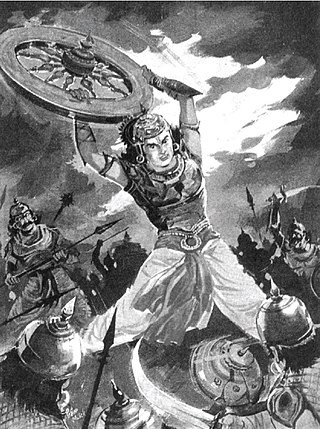
Abhimanyu is a warrior in the Hindu epic Mahabharata. He was the son of Arjuna and Subhadra, the younger sister of Krishna. Abhimanyu is portrayed as a young, strong and talented warrior. He was also one of the few individuals, along with his father, who knew the technique to enter the Chakravyuha, a powerful military formation.

Droṇa, also referred to as Dronacharya, is a major character of the Hindu epic Mahabharata.
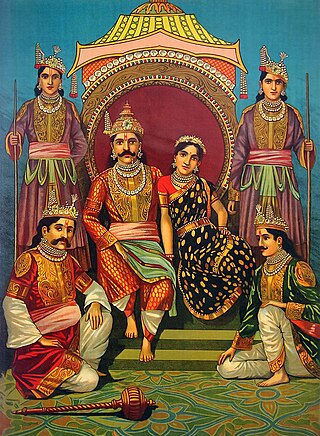
Yudhishthira also known as Dharmaraja, was the king of Indraprastha and later the Kuru Kingdom in ancient Indian History and the eldest among the five Pandava brothers, he is also one of the central figures of the ancient Hindu epic Mahabharata.
The Brahmastra is an astra that is one of the most destructive, powerful, and irresistible weapons mentioned in Hinduism. Only Parashurama, Rama, Meghanada, Bhishma, Drona, Karna, Ashwatthama, Arjuna, and Lakshmana possessed the knowledge to invoke this weapon. It was created by Brahma along with its more powerful variants Brahmashirā astra, Brahma danda, and Bhargavastra.

The Kurukshetra War, also called the Mahabharata War, is a war described in the Hindu epic poem Mahabharata, arising from a dynastic struggle between two groups of cousins, the Kauravas and the Pandavas, for the throne of Hastinapura. The war is used as the context for the dialogues of the Bhagavad Gita, which was interpolated into the Ramayana.
The Varunastra is the water weapon according to the Indian scriptures, incepted by Varuna, god of hydrosphere. In stories, it is said to assume any weapon's shape, just like water. Upon usage, it brings a large volume of water which washes away a large part of infantry. The only counter for this astra is Visoshanastra, which can be obtained by Indra, king of gods. As per the Indian legends or Puranas, this weapon is said to have been obtained by great warrior characters such as Rama, Lakshmana, Hanuman, Ravana, Meghanada, Vishvamitra, Vasishta, Arjuna, Karna, Krishna, Satyaki, Abhimanyu, Pradyumna, Drona, Bhishma and many other illustrious warrior characters.

Jayadratha is the king of the Sindhu kingdom featured in the Mahabharata. He was married to Dushala, the only sister of the hundred Kaurava brothers. The son of the king Vriddhakshatra, he is killed by Arjuna. He has a son named Suratha.

Mahabharat is an Indian Hindi-language epic television series based on the ancient Sanskrit epic Mahabharata. The original airing consisted of a total of 94 episodes and were broadcast from 2 October 1988 to 24 June 1990 on Doordarshan. It was produced by B. R. Chopra and directed by his son, Ravi Chopra. The music was composed by Raj Kamal. The script was written by Pandit Narendra Sharma and the Hindi/Urdu poet Rahi Masoom Raza, based on the epic by Vyasa. Costumes for the series were provided by Maganlal Dresswala. The serial claims to have used the Critical Edition of Bhandarkar Oriental Research Institute as its basic source with Vishnu Sitaram Sukthankar and Shripad Krishna Belwalkar as its primary editor.
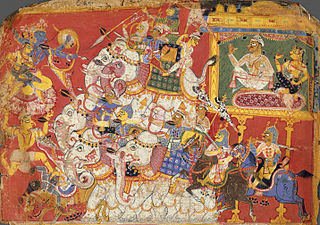
Bhagadatta was the son of Narakasura, and the king of Pragjyotisha in Hindu mythology. Bhagadatta was born from a limb of the asura called Bashkala. He was a renowned warrior, and was known to be a great friend of Indra. When Arjuna embarked on a conquest to help his brother Yudhishthira perform the rajasuya yajna, Bhagadatta was one of the first kings to be conquered by him.
An astra is a supernatural weapon in Hindu mythology. It is presided over by a specific deity and imbued with spiritual and occult powers that causes its effects.The term came to subsequently denote any weapon which was used by releasing it from one's hand, compared to keeping it one's hand.

The Bhishma Parva, or the Book of Bhishma, is the sixth of eighteen books of the Indian epic Mahabharata. It has 4 sub-books and 124 chapters.
The Drona Parva, or the Book of Drona, is the seventh of eighteen books of the Indian epic Mahabharata. Drona Parva traditionally has 8 parts and 204 chapters. The critical edition of Drona Parva has 8 parts and 173 chapters.
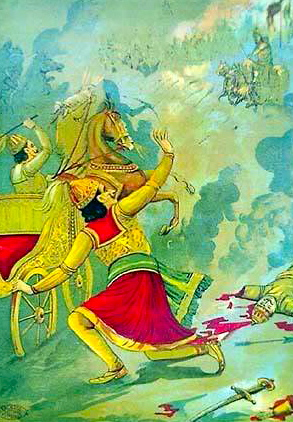
The Karna Parva, or the Book of Karna, is the eighth of eighteen books of the Indian Epic Mahabharata. Karna Parva traditionally has 96 chapters. The critical edition of Karna Parv has 69 chapters
Ashwatthama, also referred to as Drauni, is the son of Drona and a major character in the Hindu epic, the Mahabharata.
Vyasaa.k.a.Veda Vyāsa is the title given to the Rishi (sage) who comes at the end of every Dvapara Yuga to divide and compile the one Veda into four and compile the Puranas and Mahabharata for the benefit of mankind in the degraded age that follows, Kali Yuga. Vyasa is a central and revered figure in most Hindu traditions. In the 28th mahayuga (current), Krishna Dvaipāyana Vyasa was Vyasa, whose name refers to his complexion and birthplace, and who is believed to be a partial incarnation of Vishnu that occurs once in every kalpa. In the upcoming 29th mahayuga, Guru Drona's son Rishi Aswatthama will be born as the next Vyasa. In the previous 27th mahayuga, Veda Vyasa's father was Vyasa.






